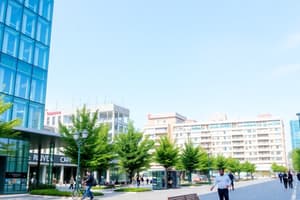Podcast
Questions and Answers
Which factor is NOT considered within the concept of Urban Typology?
Which factor is NOT considered within the concept of Urban Typology?
- Sustainability of community designs
- Morphologies related to the intensity of use
- Spatial types related to resource consumption
- Landscape aesthetics and conservation (correct)
What is the primary focus of Urban Design?
What is the primary focus of Urban Design?
- Management of public transportation systems
- Arrangement, appearance, and functionality of physical space (correct)
- Regulation of private property development
- Assessment of environmental impact assessments
What is the purpose of Legibility and Wayfinding in urban design?
What is the purpose of Legibility and Wayfinding in urban design?
- To help people navigate and understand a place (correct)
- To manage traffic flows and reduce congestion
- To optimize land use for commercial purposes
- To enforce zoning laws and building codes
Which concept involves designing places to encourage public activity?
Which concept involves designing places to encourage public activity?
What distinguishes Urban Design from Urban Planning?
What distinguishes Urban Design from Urban Planning?
What role do public spaces play in defining a city?
What role do public spaces play in defining a city?
What are some characteristics of streets in urban areas?
What are some characteristics of streets in urban areas?
Which statement best describes the Natufians?
Which statement best describes the Natufians?
What is the significance of the Ancient City of Catal Huyuk?
What is the significance of the Ancient City of Catal Huyuk?
What does the term 'community architecture' refer to?
What does the term 'community architecture' refer to?
Flashcards are hidden until you start studying
Study Notes
Urban Design Considerations
- Urban design encompasses arrangement, appearance, functionality, and space usage.
- Urban structure defines how a place is organized and how its components interconnect.
- Urban typology, density, and sustainability relate to spatial types, resource consumption, and community viability.
- Accessibility focuses on ease, safety, and choice in navigating urban environments.
- Legibility and wayfinding enhance people’s ability to orient themselves and comprehend a place’s functioning.
- Animation in design stimulates public activity and interaction in different spaces.
- Function and fit ensure areas support various intended uses effectively.
- Complementary mixed uses promote constructive interactions between different activities.
- Character and meaning in urban spaces highlight the significance of distinctiveness and place identity.
Differences between Urban Design and Urban Planning
- Urban design targets physical improvements of public spaces, while urban planning manages private development using established methods and regulations.
- Urban design creates enjoyable public spaces that foster social interactions.
- Urban planning establishes frameworks for sustainable community growth and regulatory compliance.
Public Spaces
- Quality public spaces serve as the social heart of a city, from large parks to small neighborhood areas.
- Great public spaces derive value from their design, beauty, and capacity to bring residents together.
Streets and Transport
- Streets function as vital connections, impacting city character through their dimensions and adjacent buildings.
- A distinct street network contributes to a city's uniqueness.
- Transport systems are crucial for facilitating movement within urban settings.
Ancient to Classical History of Cities
- The Natufians were an early hunter-gatherer culture in the Middle East known for establishing permanent settlements.
- Catal Huyuk (7000 BCE) was notable for attached domestic buildings and rooftop social spaces.
Effects of the Industrial Revolution
- Urbanization led to a significant population shift from rural areas to cities, primarily due to factory locations.
- Poor hygiene in densely populated areas resulted in high disease mortality rates.
- Urban challenges included overcrowding, inadequate utilities, and overcrowded conditions.
Urban Design Innovations
- Tony Garnier envisioned industrial towns with designated zoning for homes, factories, and other amenities.
- Edgar Chambless emphasized mobility and accessibility through smart design.
- The Garden City movement, started by Ebenezer Howard, proposed self-sustaining satellite towns connected to a central city by green spaces.
Historical City Layouts
- Various city layouts have been employed throughout history, including:
- Irregular layouts in medieval times.
- Grid systems in ancient Greece and Rome.
- Radial designs in early garden cities.
- Linear structures proposed in modern urban concepts.
Urban Morphology and Form
- Urban morphology studies the physical form and layout of urban environments.
- Urban form includes the overall structure of regions, towns, or precincts and features such as transportation networks and open spaces.
Studying That Suits You
Use AI to generate personalized quizzes and flashcards to suit your learning preferences.




